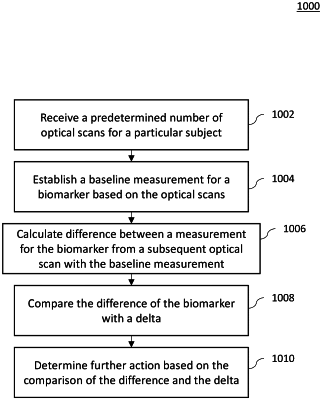| CPC A61B 5/1455 (2013.01) [A61B 5/0075 (2013.01); A61B 5/0261 (2013.01); A61B 5/14546 (2013.01)] | 17 Claims |

|
1. A system comprising:
a transdermal optical monitoring device configured to perform Attenuated Total Reflectance to generate an evanescent wave to interrogate an epidermis of a subject;
an analysis system in communication with the transdermal optical monitoring device, the analysis system configured to perform a method comprising:
receiving, from the transdermal optical monitoring device, a predetermined number of optical scans, each of the optical scans comprising data indicative of absorption of light at a range of 6.4-6.9 micrometers and a range of 8-14 micrometers by the subject, the absorption caused in response to the transdermal optical monitoring device transmitting light pulses towards the subject in a transdermal manner;
establishing a baseline measurement for an inframarker based on the data from the predetermined number of optical scans, the inframarker being indicative of a single one or a combination of biomarkers representing a physiological state of the subject, including myocardial injury and/or myocardial stress;
receiving, from the transdermal optical monitoring device, a first optical scan comprising a first measurement of the inframarker, the first optical scan being different from the predetermined number of optical scans;
calculating a difference between the first measurement of the inframarker and the baseline measurement of the inframarker;
in response to the difference exceeding a predetermined delta, detecting a change in the physiological state of the subject; and
adjusting a frequency of capturing the data from the transdermal optical monitoring device based on a magnitude of the predetermined delta, the frequency being lower when the predetermined delta is within a first predefined range, the frequency being higher when the predetermined delta is within a second predefined range.
|